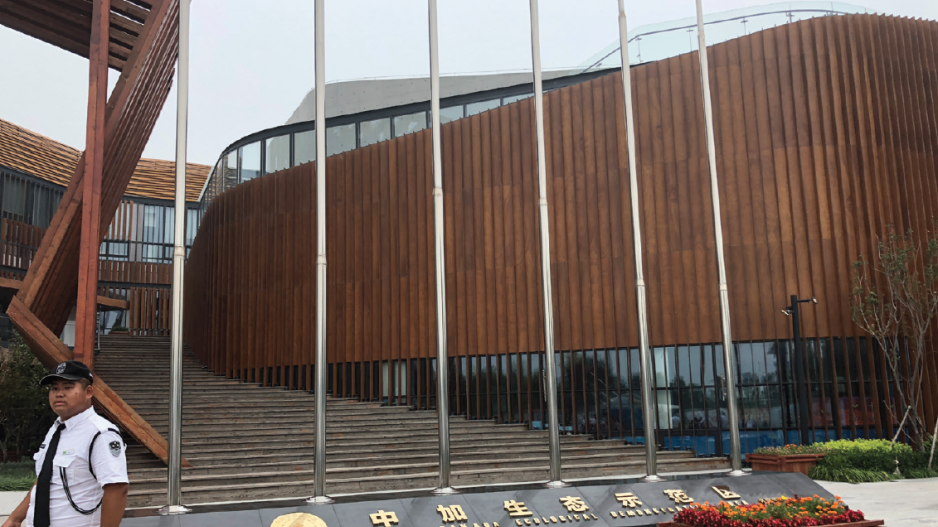BEIJING - Though it’s B.C.’s second-largest market for exported lumber, China isn’t known for its love for wood housing.
But that might be changing by the end of 2019, when 3,000-plus people in China’s fourth-largest urban area will live in more than 860,000 square feet of residential space built almost entirely out of lumber from British Columbia.
However, while officials from the company that owns and manages the Sino-Canada Ecological Demonstration Area in the northern city of Tianjin say they can foresee a much wider application of B.C. lumber in China’s housing construction scene, prices could prevent the material from being more widely adopted throughout China.
“It is my hope that we can get the word out on the price of Canadian lumber,” said Miao Bojian, assistant general manager of Beijing Science Park Development Co. Ltd., which partnered with Canada Wood Group to develop the demonstration area in 2016.
“It would be optimal if they can consider lowering the price of wood exports to China, because I really think that would play a big role in getting the Chinese market to have a bigger uptake on homes built from Canadian wood.”
However, the higher prices of B.C. lumber in China compared with cheaper sources such as Russia have not slowed the rise in Chinese interest in wood homes. Miao said the demonstration area’s first phase – 24 buildings with 100-plus housing units – has already sold out, with just short of 1,000 people expecting to move in shortly after taking delivery in May and June 2019.
The demonstration area will then quickly ramp up to more than 300 units. Miao added that Beijing Science Park Development will also build a resort hotel, pushing the demonstration area’s final wood building square footage to more than 1,184,000 square feet.
In the demonstration area’s main building – also built almost entirely of B.C. wood, as are the residential complexes – a number of models tout the benefits of Canadian lumber construction in China. The largest of them all is a model of a building that’s familiar to Vancouverites – the University of British Columbia’s (UBC) Brock Commons, the world’s tallest wood-frame building at 18 storeys.
“In the beginning, Chinese consumers didn’t get the point of wood housing,” Miao said of the initial reaction to wood houses in Tianjin. “But over time, after they started seeing the buildings here, the recognition and approval of its qualities increased steadily. After all, lumber is a good material for capturing carbon, and in terms of energy savings, insulation and overall comfort, it convinced a lot of new buyers to take a closer look.”
A resurgence in U.S. construction has driven up Canadian lumber prices. B.C. wood industry officials have also noted that, while China’s demand for Canadian wood products is increasing, the market is highly price-sensitive and not currently able to support the full range of B.C. wood products that the United States, Japan and other more traditional wood-home markets.
The inclusion of a resort hotel in the Tianjin demonstration area remains a beacon of hope for B.C.’s wood sector in China because such mid-rise structures could get around the problem of the Chinese market’s lack of familiarity with wood homes and the price barrier for consumers, in a market dominated by steel and concrete buildings.
“China has a strong domestic resort sector that is a natural fit for our log and timber-frame [houses], as well as our packaged homes,” said Jim Ivanoff, BC Wood’s director in the Asia-Pacific region, adding that a resort-driven export model can also work in other parts of Asia.
“The resort and hospitality market is also booming in Japan.… and even if the structures are concrete, the designers of these facilities are looking to incorporate more wood,” Ivanoff said. “That’s why so much of the Japanese industry is interested in projects such as Brock Commons at UBC.”
Miao said he is confident there will be a market for non-residential wood buildings like Brock Commons in China, although its popularity will again largely depend on the price of Canadian wood in the face of China’s own steel-and-concrete production capacity.
But he isn’t taking his eyes off the residential side; Miao noted that he will be visiting Canada in September in an attempt to secure land that may be used to test a six-storey wood home that meets Chinese building codes. (The code in China caps wood residential construction at five storeys.)
If that test project is successful, Miao said, it would open China’s market even wider to B.C.’s wood products. As the sales at the demonstration area show, the demand is already there in small but growing portions.
“We believe the Chinese buyers who will be attracted to Canadian wood homes will be those who care about limiting our carbon emissions, about sustainable living and about great lifestyle combined with energy savings,” Miao said, adding that China’s central government policies have sparked more interest among provincial and municipal governments in wood housing projects. •
This report is part of Business in Vancouver’s participation in the Canada China Business Council media fellowship, which includes flight, meal and accommodation costs in China.




